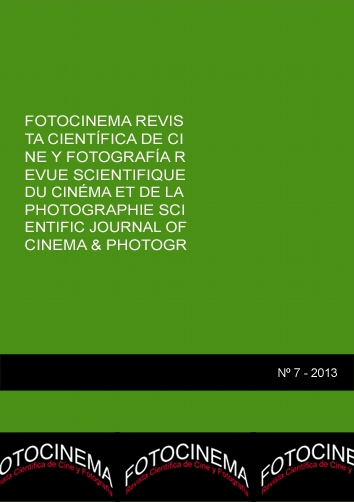Los personajes femeninos bajo la mirada del cineasta Benito Zambrano. Retrato de la mujer en Solas, Habana Blues y La voz dormida
DOI:
https://doi.org/10.24310/Fotocinema.2013.v0i7.5929Abstract
El cine, entendido como productor de imágenes y significados concretos se convierte en un medio esencial para comprender el mundo que nos rodea. Es decir, el cine debe entenderse como un espejo que reelabora la propia realidad de la que se nutre, creando nuevas representaciones que pasarán a formar parte de nuestro imaginario.En este sentido, este trabajo tiene como objetivo analizar la representación de la mujer en el cine del director español Benito Zambrano. Para ello, no sólo nos hemos centrado en observar los estereotipos que representan los personajes femeninos, sino que hemos analizado la existencia de representación femenina en cada uno de los film a través del test de Bedchel.
De esta forma, hemos podido ver como en sus tres películas (Solas, Habana Blues y La voz dormida) el cineasta muestra a mujeres que adquieren un mayor protagonismo en cada una de las historias a través de personajes de gran complejidad. Zambrano ha intercalado roles clásicos –madre, hija, esposa– con estereotipos que nada tienen que ver con los que veíamos en el cine patriarcal. Como resultado, nos encontramos con personajes mucho más independientes, fuertes y maduros que se alejan, en cierto modo, del clasicismo de la imagen femenina que pudiera estar integrado dentro del imaginario colectivo.
Abstract:
Cinema, understood as the generator of images and meanings, becomes an essential way of understanding the world around us. Moreover, cinema should be seen as a mirror that reworks the reality from which it draws its inspiration, creating new representations that will become part of our imagination.
In this sense, the aim of this article is to analyze the representation of women in the films of Spanish director Benito Zambrano. For this purpose, we have focused not only on observing stereotypes portraying female characters, but we have also discussed the existence of female representation in each of them through the Badchel test.
Downloads
Metrics
Downloads
Published
How to Cite
Issue
Section
License
All contents published in Fotocinema Revista científica de cine y fotografía are protected under the Creative Commons Attribution-NonCommercial-ShareAlike 4.0 International (CC BY-NC-SA 4.0) license. All about this license is available in the following link: <http://creativecommons.org/licenses/by-nc-sa/4.0>
Users can copy, use, redistribute, share and exhibit publicly as long as:
- The original source and authorship of the material are cited (Journal, Publisher and URL of the work).
- It is not used for comercial purposes.
- The existence of the license and its especifications are mentioned.
There are two sets of authors’ rights: moral and property rights. Moral rights are perpetual prerogatives, unrenounceable, not-transferable, unalienable, imprescriptible and inembargable. According to authors’ rights legislation, Fotocinema. Revista científica de cine y fotografía recognizes and respects authors moral rights, as well as the ownership of property rights, which will be transferred to University of Malaga in open access. The property rights are referred to the benefits that are gained by the use or the dissemination of works. Fotocinema. Revista científica de cine y fotografía is published in an open access form and it is exclusively licenced by any means for doing or authorising distribution, dissemination, reproduction, , adaptation, translation or arrangement of works.
Authors are responsable for obtaining the necessary permission to use copyrighted images.













13.png)




